by Betty Chen, CSI, and Michael Chusid, RA, FCSI
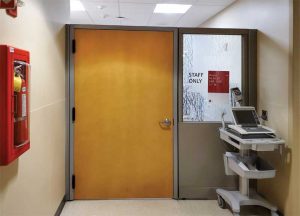
A closer hinge, an advanced type of spring hinge, incorporates the door control mechanisms into the barrel of a hinge. Innovative engineering has made closer hinges more compact and functional; the new generation of products provides unique combinations of features and benefits to address door closing challenges that are not satisfactorily met by overhead surface-mounted door closers. In addition to being used on doors with special needs, closer hinges are increasingly being employed on many types of ordinary doors due to economic, aesthetic, practical, and other reasons.
The high performance of contemporary closers can be appreciated by considering the limitations of primitive types incorporating a cord running from a door via a pulley to a counterweight mounted adjacent to the door frame. While this contraption is as dependable as gravity, its closing speed varies as the falling counterweight gains momentum. If, however, the door is released in a partially open position, the closing speed generated by the counterweight may be insufficient to cause the door to fully close. If the door is released while fully open, acceleration can cause the door to slam shut, producing objectionable noise and the potential for injury. It can be difficult to balance the force required to open the door with the force needed to close the door. Simple springs can also be used to close doors, yet have similar drawbacks, as can be attested by anyone who has heard a spring-loaded screen door slam shut.
Performance
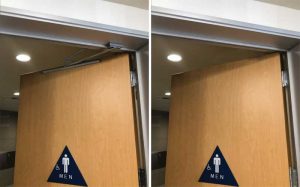
Photos © Michael Chusid
To overcome these limitations, the springs in high-performance closer hinges are adjustable and regulated by various types of mechanical and hydraulic devices. As a result, some manufacturers of closer hinges exceed the Builders Hardware Manufacturers Association (BHMA) A156.17, Self-closing Hinges & Pivots, and are able to meet some or all of the following characteristics.
Accessibility
This is the de-facto criteria for accessible doors as stipulated in the Americans with Disabilities Act (ADA)(See, also, similar requirements in the Architectural Barriers Act (ABA), Uniform Federal Accessibility Standards (UFAS), and ICC A117.1, Accessible and Usable Buildings and Facilities):
307.2 Protrusion Limits. Objects with leading edges more than 27 inches (685 mm) and not more than 80 inches (2030 mm) above the finish floor or ground shall protrude 4 inches (100 mm) maximum horizontally into the circulation path (One of the authors of this paper is approximately 1956 mm (6 ft 5 in.) tall and can attest to hazard of overhead closers protruding into doorways).
404.2.8.1 Door Closers and Gate Closers. Door closers and gate closers shall be adjusted so that from an open position of 90 degrees, the time required to move the door to a position of 12 degrees from the latch is 5 seconds minimum.
404.2.8.2 Spring Hinges. Door and gate spring hinges shall be adjusted so that from the open position of 70 degrees, the door or gate shall move to the closed position in 1.5 seconds minimum.
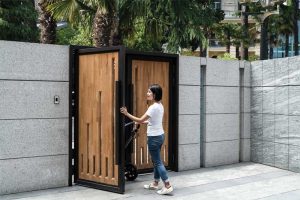
In addition to accessibility, limits on closing speed are a safety issue that can reduce door-related injuries.
404.2.9 Door and Gate Opening Force. Fire doors shall have a minimum opening force allowable by the appropriate administrative authority. The force for pushing or pulling open a door or gate other than fire doors shall be as follows: 1. Interior hinged doors and gates: 5 pounds (22.2 N) maximum.
While opening force for exterior doors is not specified in ADA, project specifications should require the minimum force practical.
Listed for fire-rated construction
To be used in an opening in a fire-resistance-rated wall or partition, closer hinges should be labeled by a recognized product certification service for use with fire-resistant doors. Up to three-hour ratings are available. Steel or stainless steel products are typically used for listed hardware.
Durability and strength
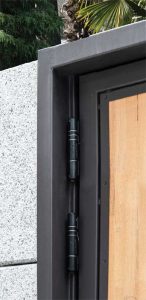
According to BHMA A156.17, Grade 1 closer hinges must pass rigorous testing for one million cycles of opening and closing on a door of a specified size and weight. They must also survive a static load test to ensure spring hinges have adequate strength to withstand anticipated loads.
Conditions of use
Closer hinges should be selected with regard for manufacturer’s recommendations for maximum operating range (degree of opening) and ambient temperature. Closer hinges that install like full mortise butt hinges are less exposed to vandalism and abuse than surface-mounted types. Some products have built in hold-open capability and door stops, eliminating the cost and clutter of using separate hardware devices.
In other cases, a swing clear type of hinge, also known as an offset door hinge, can maximize the effective width of a door opening by swinging the door out of the path of travel and is useful for wheelchair-accessible doorways. Closer hinges are also convenient in pairs of communicating doors where space between the two doors is inadequate for surface-mounted closers. Weather-resistant products should be used in wet areas.
Compatibility
Closer hinges conforming to BHMA A156.7, Template Hinge Dimensions, can be used interchangeably with ordinary door hinges. Using a familiar template simplifies door and frame preparation and allows closer hinges to be retrofit to existing doors.
Finishes and corrosion resistance
BHMA A156.18, Materials and Finishes, spells out tests for corrosion resistance and other factors affecting door finishes. It also has nomenclature for finishes and substrates. Stainless steel is recommended for exterior and harsh environments and heavy-duty doors; aluminum is also available for non-fire-rated and interior doors.
Acoustics
Closer hinges control closing speed to prevent the loud and startling noise of slamming doors. Noise control contributes to the comfort and well-being of building occupants.
Aesthetics
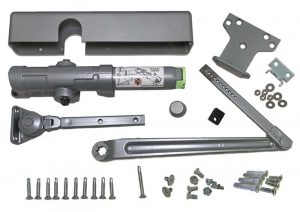
For many architectural doors, “form is the function,” and hardware must enhance (or at least not detract from) the appearance of the doorway. Barrels of some closer hinges are only modestly larger than those of standard types and are so discrete they should be considered concealed closers.





Nice to get the information
It should be door clostener.
The word closer means the person who closes, not the mechanism that
helps to close.